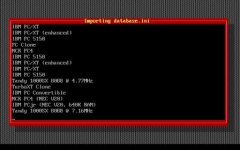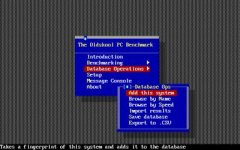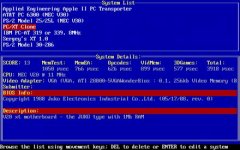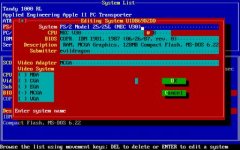Upcoming Events:
- VCF South West - June 14 - 16, Davidson-Gundy Alumni Center at University of Texas at Dallas
- VCF West - Aug 2 - 3, Computer History Museum, Mountain View, CA
- VCF Midwest - Sept 7 - 8 2024, Schaumburg, IL
- VCF SoCal - Mid February 2025, Location TBD, Southern CA
- VCF East - April 2025, Infoage Museum, Wall NJ
-
Please review our updated Terms and Rules here
- Forums
- Companies
- IBM Computers, PCs, Clones and Descendants
- PCs and Clones (XT and early AT class machines)
You are using an out of date browser. It may not display this or other websites correctly.
You should upgrade or use an alternative browser.
You should upgrade or use an alternative browser.
Looking for volunteers to help test a new benchmark
- Thread starter Trixter
- Start date
sergey
Veteran Member
Here is the result for my board (Sergey's XT 1.0) with V20HL CPU running on 13.3(3) MHz:
;Data collected by: TOPBENCH | Benchmark and detection stub | Version 0.97b
;This file contains fingerprinting information about your computer. Please
;email this file to trixter@oldskool.org with a subject line of "Benchmark" to
;help test these routines and seed the TOPBENCH database.
[UID479261CC]
MemoryTest=847
OpcodeTest=507
VidramTest=806
MemEATest=617
3DGameTest=470
Score=15
CPU=NEC V20
CPUspeed=13 MHz
BIOSinfo=unknown
MachineModel=00FC
BIOSdate=20101130
BIOSCRC16=0479
VideoSystem=VGA
VideoAdapter=VGA, Paradise PVGA1A, 8-Bit-Video, 8-Bit-ROMfixed-sync, 256kb Vi
Machine=Industrial AT 7531/2
;Data collected by: TOPBENCH | Benchmark and detection stub | Version 0.97b
;This file contains fingerprinting information about your computer. Please
;email this file to trixter@oldskool.org with a subject line of "Benchmark" to
;help test these routines and seed the TOPBENCH database.
[UID479261CC]
MemoryTest=847
OpcodeTest=507
VidramTest=806
MemEATest=617
3DGameTest=470
Score=15
CPU=NEC V20
CPUspeed=13 MHz
BIOSinfo=unknown
MachineModel=00FC
BIOSdate=20101130
BIOSCRC16=0479
VideoSystem=VGA
VideoAdapter=VGA, Paradise PVGA1A, 8-Bit-Video, 8-Bit-ROMfixed-sync, 256kb Vi
Machine=Industrial AT 7531/2
Here are more results:
286-16 AT Clone (Acer M1207 chipset)
IBM PS/2 model 30-286 with 486SLC2 50 MHz upgrade
IBM PS/2 model 55SX
IBM PS/2 model 80 (20 Mhz variant)
IBM PS/1 model 2121 (16 MHz variant)
286-16 AT Clone (Acer M1207 chipset)
Code:
[UID9C41130701]
MemoryTest=393
OpcodeTest=204
VidramTest=317
MemEATest=266
3DGameTest=195
Score=36
CPU=Intel 80286
CPUspeed=16 MHz
BIOSinfo=R(C)1985-1990, American Megatrends Inc.,All Rights Reserved.1346 Oakbrook Drive, Suite-120, Norcross, GA-30093. Phone-(404)-263-8181. (06/13/90, rev. 0)
MachineModel=01FC
BIOSdate=19900613
BIOSCRC16=9C41
VideoSystem=VGA
VideoAdapter=VGA, Trident TR8900CL or D, VESA, 768kb Video Memory, 512kb Vide
Machine=AT cloneIBM PS/2 model 30-286 with 486SLC2 50 MHz upgrade
Code:
[UIDE0D2D8679]
MemoryTest=282
OpcodeTest=253
VidramTest=1337
MemEATest=377
3DGameTest=212
Score=32
BIOSinfo= COPR. IBM 1981, 1988 (08/25/88, rev. 0)
MachineModel=09FC
BIOSdate=19880825
BIOSCRC16=E0D2
VideoSystem=VGA
Machine=PS/2 Model 30 286-10IBM PS/2 model 55SX
Code:
[UID152010882A]
MemoryTest=475
OpcodeTest=201
VidramTest=1149
MemEATest=265
3DGameTest=196
Score=21
CPU=Intel 80386SX
CPUspeed=16 MHz
BIOSinfo= COPR. IBM 1981, 1988 (11/02/88, rev. 0)
MachineModel=0CF8
BIOSdate=19881102
BIOSCRC16=1520
VideoSystem=VGA
VideoAdapter=VGA, unknown Chipset, 256kb Video Memory (BIOS)
Machine=PS/2 Model 55SX 16MHz 386SXIBM PS/2 model 80 (20 Mhz variant)
Code:
[UID383312B7C1]
MemoryTest=370
OpcodeTest=135
VidramTest=1213
MemEATest=157
3DGameTest=136
Score=26
CPU=Intel 80386DX
CPUspeed=20 MHz
BIOSinfo= COPR. IBM 1981, 1987 (10/07/87, rev. 0)
MachineModel=01F8
BIOSdate=19871007
BIOSCRC16=3833
VideoSystem=VGA
VideoAdapter=VGA, unknown Chipset, 256kb Video Memory (BIOS)
Machine=PS/2 Model 80 20MHz 386IBM PS/1 model 2121 (16 MHz variant)
Code:
[UIDE4AFC7E7C]
MemoryTest=519
OpcodeTest=199
VidramTest=319
MemEATest=259
3DGameTest=193
Score=33
CPU=Intel 80386SX
CPUspeed=16 MHz
BIOSinfo= COPR. IBM 1981, 1991 (06/25/91, rev. 0)
MachineModel=30F8
BIOSdate=19910625
BIOSCRC16=E4AF
VideoSystem=VGA
VideoAdapter=VGA, unknown Chipset, 256kb Video Memory (BIOS)
Machine=PS/1 Model 2121 16MHz 386SXTrixter
Veteran Member
Well, what did you use for your CGA compatibility test util? It had a good, clean, menu-based UI that would seem to fit the bill for a benchmark tool.
That was the TOT library (full name: Turbo Object Toolkit)
Trixter
Veteran Member
No, the Turbo Objects Toolkit was one of three menus/windows/input/screen toolkits from Bob Ainsbury, who went under the moniker TechnoJock Software, Inc. ("In the software business since Tuesday!"). They were:
TOT was created as a toolkit for those who found TV too confusing, and TGT was created as a complete Turbo Vision application framework replacement that was NOT OOP-based (some people just didn't like OOP for some reason, or didn't understand when and where to use OOP).
- Turbo Technojocks Toolkit (Turbo Pascal 4.0 and 5.0)
- Turbo Object Toolkit (Turbo Pascal 5.5-7.0)
- Turbo Gold Toolkit (Turbo Pascal 7.0, Borland Pascal 7.0)
TOT was created as a toolkit for those who found TV too confusing, and TGT was created as a complete Turbo Vision application framework replacement that was NOT OOP-based (some people just didn't like OOP for some reason, or didn't understand when and where to use OOP).
Trixter
Veteran Member
@sergey: Your board is now the fastest x86 machine benchmarked! (but just barely; it's because you run at 13.33MHz)
@nestor: Thanks for the great IBM PS/2 results!
The database is now up to 102 entries: View attachment DATABASE.TXT
@nestor: Thanks for the great IBM PS/2 results!
The database is now up to 102 entries: View attachment DATABASE.TXT
carlsson
Veteran Member
Haha, my Data General One Model 2T is the second slowest of them all, only the stock PCjr has a lower score!
dpatten
Experienced Member
Here are the results for an ESA FT-486 industrial motherboard
and a Zenith Z-386SX16 upgraded with a Cyrix 486SLCe
The Cyrix 486SLC in the Zenith machine is actually running at 16mhz since the Zenith reacted poorly to having it's oscillator changed.
[UID12E8B498]
MemoryTest=67
OpcodeTest=22
VidramTest=368
MemEATest=21
3DGameTest=17
Score=111
CPU=Intel i486DX4WB
CPUspeed=100 MHz
BIOSinfo=war,Copyright (C) 1984-99, Award Software, Inc. (10/29/99, rev. 0)
MachineModel=01FC
BIOSdate=19991029
BIOSCRC16=12E8
VideoSystem=VGA
VideoAdapter=VGA, Trident TR8900CL or D, VESA, 768kb Video Memory, 1024kb Vid
Machine=AT clone
and a Zenith Z-386SX16 upgraded with a Cyrix 486SLCe
[UID4D27135BF0]
MemoryTest=519
OpcodeTest=360
VidramTest=395
MemEATest=501
3DGameTest=326
Score=35
CPU=Cyrix/TI 486-class processor
CPUspeed=33 MHz
BIOSinfo=unknown
MachineModel=01FC
BIOSdate=20000101
BIOSCRC16=4D27
VideoSystem=VGA
VideoAdapter=VGA, unknown Cirrus CL-GD54, VESA, 256kb Video Memory (BIOS)
Machine=AT clone
Description=Zenith Z-386 SX 16
The Cyrix 486SLC in the Zenith machine is actually running at 16mhz since the Zenith reacted poorly to having it's oscillator changed.
Last edited:
In any case, I’ve got a console/text-only utility that can do all of the above, so I was able to import all 80+ contributed system entries that people have listed in this thread and also emailed me personally into a single database, and it’s available here: ftp://ftp.oldskool.org/pub/TOPBENCH/database_20120729.zip In that file you'll find both the "ini" style format that is easy to read, and also a .CSV you can load into your favorite spreadsheet.
I can't find my results in the database but otoh, I never did e-mail them to you.
DOS lives on!!
Veteran Member
IBM PC AT with 512KB onboard memory, and an Intel Aboveboard AT providing the memory to bump it to 640KB, then providing an additional 2mb.
Code:
[UID6DBAFD481]
MemoryTest=1245
OpcodeTest=539
VidramTest=919
MemEATest=705
3DGameTest=523
Score=13
CPU=Intel 80286
CPUspeed=6 MHz
BIOSinfo=6181028 COPR. IBM 1984 (01/10/84, rev. 0)
MachineModel=0000
BIOSdate=19840110
BIOSCRC16=6DBA
VideoSystem=VGA
VideoAdapter=VGA, Paradise PVGA1A, 8-Bit-Video, 8-Bit-ROMfixed-sync, 256kb Vi
Machine=PC/ATCompgeke
Veteran Member
Here are some complete, and some incomplete results. I've noticed the program chokes up trying to work with newer hardware.
1.) Compaq Presario 1220. 200 MHz Cyrix MediaGXm.
[UID3AF2A168]
MemoryTest=51553
OpcodeTest=51549
VidramTest=51686
MemEATest=51552
3DGameTest=51585
Score=339
CPU=Cyrix GXm (clock x6 mode)
CPUspeed=969 MHz <-- This is odd, as the detection for this clock is rougly 4 times faster than it should be.
BIOSinfo=unknown
MachineModel=01FC
BIOSdate=19980219
BIOSCRC16=3AF2
VideoSystem=VGA
VideoAdapter=VGA, Yamaha 6388, VESA, 256kb Video Memory (BIOS)
Machine=AT clone
2.) Compaq Presario 1200. 500 MHz K6-II.
[UID98FDBEC]
MemoryTest=4
OpcodeTest=8
VidramTest=99
MemEATest=7
3DGameTest=5
Score=474
CPU=AMD K6-2
CPUspeed=500 MHz
BIOSinfo=unknown
MachineModel=01FC
BIOSdate=20000114
BIOSCRC16=98FD
VideoSystem=VGA
VideoAdapter=VGA, Trident GUI9420, VESA, 768kb Video Memory, 4096kb Video Mem
Machine=AT clone
3.) Core i5 @ 2.66 GHz. Funny it's seen as a Pentium II...
[UID90EF3B677]
MemoryTest=0
OpcodeTest=0
VidramTest=128
MemEATest=0
3DGameTest=0
Score=387
CPU=Intel Pentium II
CPUspeed=2660 MHz
BIOSinfo=(C)1985-2009,American Megatrends, Inc.All Rights Reserved. (09/23/09, rev. 0)
MachineModel=01FC
BIOSdate=20090923
BIOSCRC16=90EF
VideoSystem=VGA
VideoAdapter=VGA, ATI Bios : 0.0, VESA, 256kb Video Memory (BIOS)
Machine=AT clone
4.) HP M9452p with a 2.66 GHz Core 2 Duo E6700 instead of the original Core 2 Quad (didn't get that, probably would've done worse anyways). GeForce 9800 GTX+.
[UID54497C4DE]
MemoryTest=1
OpcodeTest=0
VidramTest=146
MemEATest=0
3DGameTest=0
Score=327
CPU=Intel Pentium Pro (undistinguished)
CPUspeed=2667 MHz
BIOSinfo=(C)1985-2007,American Megatrends, Inc.All Rights Reserved,6145F Northbelt Parkway,GA-30071,USA.(770)-246-8600. (01/17/08, rev. 0)
MachineModel=01FC
BIOSdate=20080117
BIOSCRC16=5449
VideoSystem=VGA
VideoAdapter=VGA, VESA, 256kb Video Memory (BIOS)
Machine=AT clone
5.) Dell Latitude E6400. 2.93 GHz Core 2 Duo T9800, nVidia NVS160M.
[UIDAE2BF3D2] <-- Latitude E6400
MemoryTest=0
OpcodeTest=1
VidramTest=297
MemEATest=0
3DGameTest=0
Score=165
CPU=Intel Pentium III
CPUspeed=2926 MHz
BIOSinfo=Copyright (C) 1985-1988 Phoenix Technologies Ltd. (02/16/11, rev. 0)
MachineModel=01FC
BIOSdate=20110216
BIOSCRC16=AE2B
VideoSystem=VGA
VideoAdapter=VGA, VESA, 256kb Video Memory (BIOS)
Machine=Dell unknown; ID isFE /AT clone
6.) Dell Optiplex G1 with a 550 MHz Pentium III
[UID12541E113]
MemoryTest=5
OpcodeTest=5
VidramTest=101
MemEATest=5
3DGameTest=5
Score=439
CPU=Intel Pentium III
CPUspeed=550 MHz
BIOSinfo=Copyright (C) 1985-1988 Phoenix Technologies Ltd. (04/29/03, rev. 0)
MachineModel=01FC
BIOSdate=20030429
BIOSCRC16=1254
VideoSystem=VGA
7.) Dell Optiplex G1 with a Powerleap IP3/T Slocket adapter with a 1 GHz Celeron on it.
[UID12541F573]
MemoryTest=5
OpcodeTest=4
VidramTest=103
MemEATest=5
3DGameTest=5
Score=464
CPU=Intel Pentium Pro (undistinguished)
CPUspeed=1000 MHz
BIOSinfo=Copyright (C) 1985-1988 Phoenix Technologies Ltd. (04/29/03, rev. 0)
MachineModel=01FC
BIOSdate=20030429
BIOSCRC16=1254
VideoSystem=VGA
VideoAdapter=VGA, ATI Bios : 0.0, VESA, 256kb Video Memory (BIOS)
Machine=Dell unknown; ID is89 /AT clone
8.) And finally, Dell Inspiron Mini 1010, 1.33 GHz Intel Atom Z520.
[UIDF1B114DAB]
MemoryTest=9
OpcodeTest=5
VidramTest=178
MemEATest=4
3DGameTest=5
Score=249
CPU=Intel Pentium Pro (undistinguished)
CPUspeed=1330 MHz
BIOSinfo=unknown
MachineModel=01FC
BIOSdate=20091027
BIOSCRC16=F1B1
VideoSystem=VGA
VideoAdapter=VGA, VESA, 256kb Video Memory (BIOS)
Machine=Dell unknown; ID isFE /AT clone.
Out of these it seems the AMD K6 did the best, while the program didn't like systems using PCI-e (basically everything but the Dell G1 and the Compaqs).
Edit: Here's two more, the first is a Dell Latitude D600. 1.7 GHz Pentium M, ATI Mobility Radeon 9000.
[UIDDAD91C818]
MemoryTest=0
OpcodeTest=1
VidramTest=105
MemEATest=0
3DGameTest=0
Score=463
CPU=Intel Pentium Pro (undistinguished)
CPUspeed=1694 MHz
BIOSinfo=Copyright (C) 1985-1988 Phoenix Technologies Ltd. (06/29/05, rev. 0)
MachineModel=01FC
BIOSdate=20050629
BIOSCRC16=DAD9
VideoSystem=VGA
VideoAdapter=VGA, ATI Bios : 0.0, VESA, 256kb Video Memory (BIOS)
Machine=Dell unknown; ID isFE /AT clone
And my Compaq Prolinea 4/33, only with a 66 MHz 486 DX2 instead of a 33 MHz DX now.
[UIDEC0E1481D]
MemoryTest=90
OpcodeTest=50
VidramTest=84
MemEATest=74
3DGameTest=36
Score=218
CPU=Intel i486DX2
CPUspeed=66 MHz
BIOSinfo=\CL GE S CAB2/NPBCWKDJWDJCDSJCGCMRGTRZNQL(C)Copyright COMPAQ Computer Corporation 1982,93* (07/03/93, rev. 0)
MachineModel=01FC
BIOSdate=19930703
BIOSCRC16=EC0E
VideoSystem=VGA
VideoAdapter=VGA, Tseng ET 4000W32, DRAM, 256kb Video Memory (BIOS)
Machine=AT clone
VideoAdapter=VGA, ATI Bios : 0.0, VESA, 256kb Video Memory (BIOS)
Machine=Dell unknown; ID is89 /AT clone
1.) Compaq Presario 1220. 200 MHz Cyrix MediaGXm.
[UID3AF2A168]
MemoryTest=51553
OpcodeTest=51549
VidramTest=51686
MemEATest=51552
3DGameTest=51585
Score=339
CPU=Cyrix GXm (clock x6 mode)
CPUspeed=969 MHz <-- This is odd, as the detection for this clock is rougly 4 times faster than it should be.
BIOSinfo=unknown
MachineModel=01FC
BIOSdate=19980219
BIOSCRC16=3AF2
VideoSystem=VGA
VideoAdapter=VGA, Yamaha 6388, VESA, 256kb Video Memory (BIOS)
Machine=AT clone
2.) Compaq Presario 1200. 500 MHz K6-II.
[UID98FDBEC]
MemoryTest=4
OpcodeTest=8
VidramTest=99
MemEATest=7
3DGameTest=5
Score=474
CPU=AMD K6-2
CPUspeed=500 MHz
BIOSinfo=unknown
MachineModel=01FC
BIOSdate=20000114
BIOSCRC16=98FD
VideoSystem=VGA
VideoAdapter=VGA, Trident GUI9420, VESA, 768kb Video Memory, 4096kb Video Mem
Machine=AT clone
3.) Core i5 @ 2.66 GHz. Funny it's seen as a Pentium II...
[UID90EF3B677]
MemoryTest=0
OpcodeTest=0
VidramTest=128
MemEATest=0
3DGameTest=0
Score=387
CPU=Intel Pentium II
CPUspeed=2660 MHz
BIOSinfo=(C)1985-2009,American Megatrends, Inc.All Rights Reserved. (09/23/09, rev. 0)
MachineModel=01FC
BIOSdate=20090923
BIOSCRC16=90EF
VideoSystem=VGA
VideoAdapter=VGA, ATI Bios : 0.0, VESA, 256kb Video Memory (BIOS)
Machine=AT clone
4.) HP M9452p with a 2.66 GHz Core 2 Duo E6700 instead of the original Core 2 Quad (didn't get that, probably would've done worse anyways). GeForce 9800 GTX+.
[UID54497C4DE]
MemoryTest=1
OpcodeTest=0
VidramTest=146
MemEATest=0
3DGameTest=0
Score=327
CPU=Intel Pentium Pro (undistinguished)
CPUspeed=2667 MHz
BIOSinfo=(C)1985-2007,American Megatrends, Inc.All Rights Reserved,6145F Northbelt Parkway,GA-30071,USA.(770)-246-8600. (01/17/08, rev. 0)
MachineModel=01FC
BIOSdate=20080117
BIOSCRC16=5449
VideoSystem=VGA
VideoAdapter=VGA, VESA, 256kb Video Memory (BIOS)
Machine=AT clone
5.) Dell Latitude E6400. 2.93 GHz Core 2 Duo T9800, nVidia NVS160M.
[UIDAE2BF3D2] <-- Latitude E6400
MemoryTest=0
OpcodeTest=1
VidramTest=297
MemEATest=0
3DGameTest=0
Score=165
CPU=Intel Pentium III
CPUspeed=2926 MHz
BIOSinfo=Copyright (C) 1985-1988 Phoenix Technologies Ltd. (02/16/11, rev. 0)
MachineModel=01FC
BIOSdate=20110216
BIOSCRC16=AE2B
VideoSystem=VGA
VideoAdapter=VGA, VESA, 256kb Video Memory (BIOS)
Machine=Dell unknown; ID isFE /AT clone
6.) Dell Optiplex G1 with a 550 MHz Pentium III
[UID12541E113]
MemoryTest=5
OpcodeTest=5
VidramTest=101
MemEATest=5
3DGameTest=5
Score=439
CPU=Intel Pentium III
CPUspeed=550 MHz
BIOSinfo=Copyright (C) 1985-1988 Phoenix Technologies Ltd. (04/29/03, rev. 0)
MachineModel=01FC
BIOSdate=20030429
BIOSCRC16=1254
VideoSystem=VGA
7.) Dell Optiplex G1 with a Powerleap IP3/T Slocket adapter with a 1 GHz Celeron on it.
[UID12541F573]
MemoryTest=5
OpcodeTest=4
VidramTest=103
MemEATest=5
3DGameTest=5
Score=464
CPU=Intel Pentium Pro (undistinguished)
CPUspeed=1000 MHz
BIOSinfo=Copyright (C) 1985-1988 Phoenix Technologies Ltd. (04/29/03, rev. 0)
MachineModel=01FC
BIOSdate=20030429
BIOSCRC16=1254
VideoSystem=VGA
VideoAdapter=VGA, ATI Bios : 0.0, VESA, 256kb Video Memory (BIOS)
Machine=Dell unknown; ID is89 /AT clone
8.) And finally, Dell Inspiron Mini 1010, 1.33 GHz Intel Atom Z520.
[UIDF1B114DAB]
MemoryTest=9
OpcodeTest=5
VidramTest=178
MemEATest=4
3DGameTest=5
Score=249
CPU=Intel Pentium Pro (undistinguished)
CPUspeed=1330 MHz
BIOSinfo=unknown
MachineModel=01FC
BIOSdate=20091027
BIOSCRC16=F1B1
VideoSystem=VGA
VideoAdapter=VGA, VESA, 256kb Video Memory (BIOS)
Machine=Dell unknown; ID isFE /AT clone.
Out of these it seems the AMD K6 did the best, while the program didn't like systems using PCI-e (basically everything but the Dell G1 and the Compaqs).
Edit: Here's two more, the first is a Dell Latitude D600. 1.7 GHz Pentium M, ATI Mobility Radeon 9000.
[UIDDAD91C818]
MemoryTest=0
OpcodeTest=1
VidramTest=105
MemEATest=0
3DGameTest=0
Score=463
CPU=Intel Pentium Pro (undistinguished)
CPUspeed=1694 MHz
BIOSinfo=Copyright (C) 1985-1988 Phoenix Technologies Ltd. (06/29/05, rev. 0)
MachineModel=01FC
BIOSdate=20050629
BIOSCRC16=DAD9
VideoSystem=VGA
VideoAdapter=VGA, ATI Bios : 0.0, VESA, 256kb Video Memory (BIOS)
Machine=Dell unknown; ID isFE /AT clone
And my Compaq Prolinea 4/33, only with a 66 MHz 486 DX2 instead of a 33 MHz DX now.
[UIDEC0E1481D]
MemoryTest=90
OpcodeTest=50
VidramTest=84
MemEATest=74
3DGameTest=36
Score=218
CPU=Intel i486DX2
CPUspeed=66 MHz
BIOSinfo=\CL GE S CAB2/NPBCWKDJWDJCDSJCGCMRGTRZNQL(C)Copyright COMPAQ Computer Corporation 1982,93* (07/03/93, rev. 0)
MachineModel=01FC
BIOSdate=19930703
BIOSCRC16=EC0E
VideoSystem=VGA
VideoAdapter=VGA, Tseng ET 4000W32, DRAM, 256kb Video Memory (BIOS)
Machine=AT clone
VideoAdapter=VGA, ATI Bios : 0.0, VESA, 256kb Video Memory (BIOS)
Machine=Dell unknown; ID is89 /AT clone
Last edited:
Trixter
Veteran Member
Here are some complete, and some incomplete results. I've noticed the program chokes up trying to work with newer hardware.
It wasn't designed for modern hardware; in fact, my CPU detection routines end at roughly a Pentium III
Some of these results are suspect; any microsecond test with numbers over roughly 10000 is generally impossible, like these:
1.) Compaq Presario 1220. 200 MHz Cyrix MediaGXm.
[UID3AF2A168]
MemoryTest=51553
OpcodeTest=51549
VidramTest=51686
MemEATest=51552
3DGameTest=51585
Did you run the stub on a cleanly-booted DOS, or was it under something else like Windows?
Compgeke
Veteran Member
I ran it off MS-DOS 6.22 setup disk as running it from Windows 98 in MS-DOS mode (clean boot) it would give me a Runtime Error 209.
I'm going to go re-run after checking the BIOS, as I have yet to go into it and see what the settings are.
I'm going to go re-run after checking the BIOS, as I have yet to go into it and see what the settings are.
sergey
Veteran Member
It wasn't designed for modern hardware; in fact, my CPU detection routines end at roughly a Pentium IIIIn the full tool, the user will be immediately presented with an edit form so that they can fix incorrect detection results.
It is not very difficult to detect newer CPUs (using CPUID instruction and such). I did some work on this previously (for Intel CPUs only), so if you want I can provide some examples...
Trixter
Veteran Member
@compgeke: Thanks very much for running it clean. Run it a few times and see if you get those goofy numbers on every run. If you do, I'll have to do some investigation.
@sergey: I didn't bother implementing CPUID because the benchmark is not meant to be run on machines that fast, other than as a curiosity as to which CPU can run real-mode 16-bit code the fastest. It looks like http://en.wikipedia.org/wiki/CPUID has everything I'll need to implement it. Hopefully it doesn't require protected mode. If you'd like to email me your code, I would be happy to look at it
@sergey: I didn't bother implementing CPUID because the benchmark is not meant to be run on machines that fast, other than as a curiosity as to which CPU can run real-mode 16-bit code the fastest. It looks like http://en.wikipedia.org/wiki/CPUID has everything I'll need to implement it. Hopefully it doesn't require protected mode. If you'd like to email me your code, I would be happy to look at it
Compgeke
Veteran Member
Ok, I re-ran it and the individual scores were all around 51,000, and got a total score of...7. The CPU was also detected as running at 4780 MHz...5 GHz fanless processor? 
Edit:
Ran the test from the DOS 6.22 disk again:
[UID3AF2C93EE]
MemoryTest=51565
OpcodeTest=51565
VidramTest=51711
MemEATest=51551
3DGameTest=51546
Score=7
CPU=Cyrix GXm (clock x6 mode)
CPUspeed=4780 MHz
BIOSinfo=unknown
MachineModel=01FC
BIOSdate=19980219
BIOSCRC16=3AF2
VideoSystem=VGA
VideoAdapter=VGA, Yamaha 6388, VESA, 256kb Video Memory (BIOS)
Machine=AT clone
And from 98 in Safemode and Command Prompt:
[UID3AF2CB1B2]
MemoryTest=51554
OpcodeTest=51578
VidramTest=51692
MemEATest=51565
3DGameTest=51573
Score=290
CPU=Cyrix GXm (clock x6 mode)
CPUspeed=969 MHz
BIOSinfo=unknown
MachineModel=01FC
BIOSdate=19980219
BIOSCRC16=3AF2
VideoSystem=VGA
VideoAdapter=VGA, Yamaha 6388, VESA, 256kb Video Memory (BIOS)
Machine=AT clone
Edit:
Ran the test from the DOS 6.22 disk again:
[UID3AF2C93EE]
MemoryTest=51565
OpcodeTest=51565
VidramTest=51711
MemEATest=51551
3DGameTest=51546
Score=7
CPU=Cyrix GXm (clock x6 mode)
CPUspeed=4780 MHz
BIOSinfo=unknown
MachineModel=01FC
BIOSdate=19980219
BIOSCRC16=3AF2
VideoSystem=VGA
VideoAdapter=VGA, Yamaha 6388, VESA, 256kb Video Memory (BIOS)
Machine=AT clone
And from 98 in Safemode and Command Prompt:
[UID3AF2CB1B2]
MemoryTest=51554
OpcodeTest=51578
VidramTest=51692
MemEATest=51565
3DGameTest=51573
Score=290
CPU=Cyrix GXm (clock x6 mode)
CPUspeed=969 MHz
BIOSinfo=unknown
MachineModel=01FC
BIOSdate=19980219
BIOSCRC16=3AF2
VideoSystem=VGA
VideoAdapter=VGA, Yamaha 6388, VESA, 256kb Video Memory (BIOS)
Machine=AT clone
Last edited:
Trixter
Veteran Member
Well, I guess we found the first CPU architecture I can't properly support then  I don't own one of those machines to test/develop on, and since it is way out of scope for the benchmark, I'm not really going to spend time trying to obtain one. Sorry.
I don't own one of those machines to test/develop on, and since it is way out of scope for the benchmark, I'm not really going to spend time trying to obtain one. Sorry.
The timing code is pretty simple; it disables all interrupts, times an empty loop and records it, then times the metric code and subtracts the empty loop number to get the final result. On progressively faster machines, the timing numbers decrease down to 0 while the Score continues to rise (because the score is based on the number of iterations the metrics run in a 50ms period). On a crazy fast machine, all metrics take "0" microseconds to run and the Score is 500+. So when you see numbers of ~50000 then it means something has gone really quite wrong, and I haven't been able to reproduce that on anything I own.
The only thing I can think of is that maybe that machine is switching between power-save modes or something. Or maybe disk access is causing it to slow the bus way down, etc. Try running "dstub" if you haven't already been, as that minimizes disk accesses somewhat. But if you run dstub 3 times in a row and still get crazy numbers then I'm afraid there's not much I can do about it.
The timing code is pretty simple; it disables all interrupts, times an empty loop and records it, then times the metric code and subtracts the empty loop number to get the final result. On progressively faster machines, the timing numbers decrease down to 0 while the Score continues to rise (because the score is based on the number of iterations the metrics run in a 50ms period). On a crazy fast machine, all metrics take "0" microseconds to run and the Score is 500+. So when you see numbers of ~50000 then it means something has gone really quite wrong, and I haven't been able to reproduce that on anything I own.
The only thing I can think of is that maybe that machine is switching between power-save modes or something. Or maybe disk access is causing it to slow the bus way down, etc. Try running "dstub" if you haven't already been, as that minimizes disk accesses somewhat. But if you run dstub 3 times in a row and still get crazy numbers then I'm afraid there's not much I can do about it.
Compgeke
Veteran Member
I'll have to do that when I get back home, although I will say that it seems no one has a MediaGX based system, and it wouldn't surprise me that nothing runs right (since it's basically 2 chips that control everything).
Trixter
Veteran Member
I've made substantial progress on the full benchmarking tool, and am comfortable enough to show some screenshots on how it is going:





(Sorry for the screenshot quality, I don't know why this board insists on mangling perfectly decent PNG files)
The program is keyboard-driven, although I added mouse support for the edit form since it seemed to make sense to do so there. It downgrades to MDA and upgrades to EGA/VGA 43/50-line mode without any problems.





(Sorry for the screenshot quality, I don't know why this board insists on mangling perfectly decent PNG files)
The program is keyboard-driven, although I added mouse support for the edit form since it seemed to make sense to do so there. It downgrades to MDA and upgrades to EGA/VGA 43/50-line mode without any problems.
